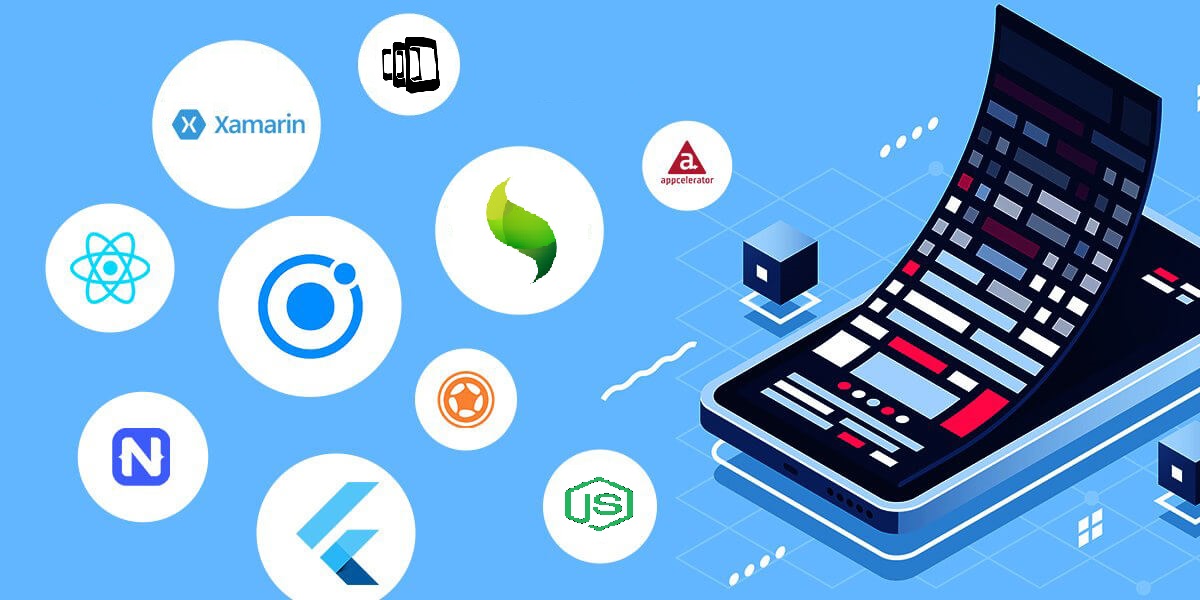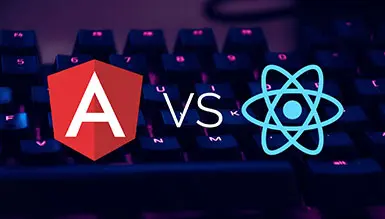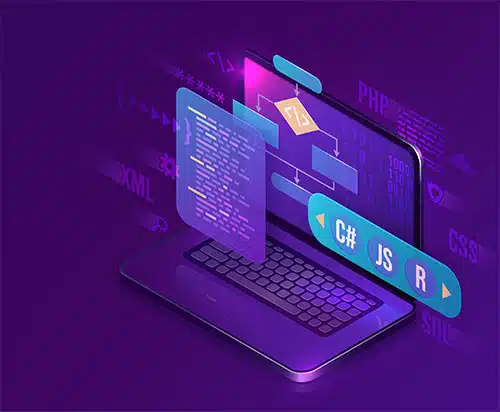Cross-platform app development has a lot going for it, which is why it’s so popular now. As its reach grew, several cross-platform app development tools and frameworks started to show up on the market, first slowly and then all at once, along with every other mobile app development company trying their hand at this exciting and unique technology.
As a result, there are now a lot of these kinds of tools and frameworks, which you as a developer may find confusing. To help you find the best and most ideal cross-platform framework, here is a list of the best cross-platform app development frameworks.
Before something can be called the “best” in a field or category, it must meet specific criteria. In the same way, when deciding on the best cross-platform mobile development tools and frameworks, several important factors were taken into account so that each choice could be judged fairly.
What Are the Best Frameworks for Cross-Platform Mobile App Development?
Cross-platform software can run on different computer platforms, such as Android, iOS, Windows, Blackberry, etc. Apps built on this framework don’t need to be coded separately for each platform. Instead, they only need to be coded once, which gives them the foundation they need to run well on all platforms. It is one of the most popular ways to build apps today, and almost all of the best companies that offer mobile app development services swear by it.
Our experts can help you in developing your next world-class apps.
What are the best frameworks for making mobile apps that work on multiple platforms?
1: Ionic
Based on AngularJS, Ionic is one of the best and most popular cross-platform app frameworks. It lets developers access native platform controllers using various languages, such as HTML5, JavaScript, CSS, and Cordova wrapper.
Ionic lets developers make apps with creative user interfaces and features that are easy for people to use. The apps created with this framework are very interactive and feel like native apps, so Ionic is also an excellent choice for PWA development.
Features
- It is an open-source front-end framework, meaning the code structure can be changed to fit each developer’s needs and saves time.
- Ionic is built on a SAAS user interface (UI) framework that was made especially for mobile operating systems. It has a lot of UI components that can be used to build strong apps.
- One of the best things about it is that it is based on AngularJS, which makes it easy to add extensions to HTML’s syntax and core functionality to add useful and attractive features and components to the app.
2: React Native
React Native is hard to leave out of a list of app frameworks that work on multiple platforms. It is a framework built on JavaScript used to write real code and give mobile apps that work on Android and iOS the feel of a native app. Because it has so many great features, developers and businesses choose React Native as the best platform for their apps. React Native combines the good things about JavaScript and React.JS and gives developers the option of writing modules in Objective-C, Swift, or Java.
Features:
- It’s good that React Native, like Ionic, is an open-source, cross-platform app framework. Because of this, it has a big group of people who help support and improve it by fixing bugs, making changes, and adding new features.
- One benefit of cross-platform development is that it only needs to be coded once (WORA) to make apps for different platforms like Android and iOS. This solves one of the biggest problems with other frameworks: developers had to write code twice for the same app to work on different platforms.
- One-time coding immediately cuts the time it takes to build an app and keeps the cost of building a React Native app at its lowest.
3: Flutter
In 2017, Google released Flutter, an impressive app framework that works on multiple platforms. It is a software development kit that makes it easier to make apps for Android and iOS. It is also the main and most important way to make Google Fuschia apps.
Flutter makes it easy to make apps that run well and consistently on multiple platforms.
Here are some great things about Flutter that make it a tremendous cross-platform developer framework
Features:
- Flutter makes GPUs portable, giving UIs power and letting them work on the newest interfaces.
- The Flutter cross-platform app framework speeds up and saves money on MVP development.
- Developers can make a widget tree automatically and quickly, and they can understand how the code has changed.
4: Xamarin
Cross-platform frameworks for making apps with Xamarin are very different from the frameworks we’ve talked about so far. It is a streamlined framework for building apps for Android, Windows, and iOS with C# and.Net instead of JS libraries and HTML. It lets developers build an app using 90% of the same code for three different platforms.
With the help of its outstanding APIs, Xamarin makes apps that look and feel like native apps. This makes it harder to choose between Xamarin and React Native.
Features
- Apps built on the Xamarin framework are written in C#, a modern cross-platform app development language with advantages over Objective-C and Java.
- With Xamarin, developers can make apps that work just like native apps. With the help of plugins and APIs that work with standard devices, it reduces hardware compatibility problems by a large amount.
- Objective-C, Java, and C++ libraries can be used directly with Xamarin. This lets developers use many third-party codebases encrypted in Java, Objective-C, or C++. This makes it one of the best cross-platform frameworks by a wide margin.
5: NativeScript:
NativeScript is a free, cross-platform framework that is based on JavaScript and seems to be a perfect one. It wouldn’t be wrong to say that NativeScript is the best choice for developers who want WORA functionality.
NativeScript also has all native APIs, so developers can use existing plugins from NPM and reuse them in their projects.
Features
- Native Script makes UI that is beautiful, easy to use, and native to the platform, and it does all of this without Web Views. Developers only have to define something once, and then NativeScript will change itself to run everywhere. They can even change how the UI looks on specific devices and screens.
- Unlike React Native, Native Script gives developers a complete web resource with plugins for all kinds of solutions. This eliminates the need for solutions from outside sources.
- Native Script lets developers easily access native Android and iOS APIs, so they don’t need to know any other native programming languages.
6: Node.js
Node.js is a great framework for making apps that work on multiple platforms and is a runtime framework for JavaScript that is built on the Chrome V8 JavaScript engine. It is an open-source environment that makes making scalable server-side networking apps easier. Cross-platform apps made with Node.js are fast and efficient by design. The framework can handle multiple connections at the same time. It also has an extensive library of JavaScript modules that make web apps more accessible.
Features
- Node.js APIs are asynchronous, which means they don’t block. This means that Node.js servers don’t have to wait for data from APIs. After calling it, it goes right to another API. With Node.js’s notification system, the server can get a response from the last API call.
- The Node.js library is built on Chrome’s V8 engine, making it very fast at running code.
- Node.js apps that run on multiple platforms don’t buffer; instead, they send out data in chunks.
7: Appcelerator Titanium
Appcelerator is one of the many cross-platform app development tools that make mobile apps more accessible and smoother. It is a great way to create apps that work on multiple platforms with only one code base. Its main goal is to speed up the app development process by using JavaScript code’s native components.
Features
- Appcelerator has different tools for making apps quickly. This means that making a prototype to test how users interact with UI will take much less time and work.
- It has ArrowDB, a schema-less data store that lets developers deploy data models without having to do any extra work to set them up.
- Appcelerator has pre-built connectors for Microsoft Azure, Microsoft SQL, Salesforce, Box, and so on.
8: PhoneGap
Phone Gap (Cordova) is an excellent cross-platform framework for mobile development that uses CSS, JavaScript, and HTML5. It also gives developers a cloud solution that lets them share their apps as they’re being made so that other developers can provide feedback.
It makes impressive apps by using web technologies that already exist. PhoneGap is also great because it fully supports the device’s built-in features, such as GPS, camera, phonebook, storage, etc.
- Its also great cross-platform app development framework because it lets developers make cross-platform apps using existing web technologies, such as HTML5, CSS3, and JavaScript.
- PhoneGap is a cross-platform framework, so you can use a single code base to make apps for iOS, Android, Windows Phone, BlackBerry, and other platforms.
- It uses a pluggable architecture, which means that access to native device APIs can be made more flexible by adding modules.
9: The Sencha Touch
Sencha Touch has been around for almost a decade and helps make web-based, cross-platform apps. It is usually used to make efficient apps that use hardware acceleration techniques. Using Sencha Touch, developers can make UI components and libraries that have been tested and are safe to use. It is possible to build and manage large business apps efficiently and effectively.
Features:
- It is known for having built-in themes that look like they were made for all major platforms, such as Android, iOS, BlackBerry, Windows Phone, etc.
- Sencha Touch’s support for Cordova integration for native API access and packaging is one of its most prominent features.
- It lets both new and old codes work together.
10: Corona SDK
With Corona SDK, programmers can make 2D mobile apps for all the major platforms, like Kindle and Windows. It makes making mobile apps and games 10 times faster. The framework gets excellent results because its backend framework is based on Lua, a lightweight programming language that can be used in more than one way. The language emphasises speed, portability, extension, scalability, and usability. It is also a free framework that works on both Mac OS X and Windows and allows for real-time testing.
Features
- It has more than 1000 APIs that allow developers to do things like sprite animations, audio and music, Box2D physics, object tweening, texture management, native elements, data, and so on.
- Corona SDK responds almost instantly to changes in the code and shows how the app will work on an actual device in real-time.
- It works with almost 200 plugins, such as those for in-app advertising, analytics, media, and hardware.
What Are the Advantages of Cross-Platform Application Development Frameworks?
Maximum Target Audience Exposure
A cross-platform mobile development method lets you build an app and send it to different platforms, like the web. This means that by making one app, you can target both the iOS and Android platforms, which increases your reach.
Lower Development Costs
The idea behind cross-platform application development is “write it once, run it everywhere.” Using tools for agile application development and codes that can be used more than once can lower the cost of development. Cross-platform applications are the only practical way to improve your business on many platforms and tools.
Easier upkeep and deployment
Since only one application works on all platforms, it is easier to keep up with changes and send code. All platforms and devices can quickly sync updates, saving time and money. Also, if a bug is found in the common codebase, it only needs to be fixed once. App Developers can save time and money by doing things like this.
More Rapid Development
Creating cross-platform apps is also suitable for both sides because the development process goes quickly. Using a single source code for multiple platforms can cut development time by 50–80%. It helps you get a business app with many features in less time. In cross-platform application development, the developers can meet the expected deadlines.
Reusable Code
The code can be used repeatedly, another benefit of this platform. Instead of making new codes for each forum, developers can use the same one. This saves time and money because it eliminates the need to make codes more than once.
Cloud Integration
Cross-platform mobile apps work on all platforms and can use different plugins built into the cloud settings. In other words, the plugins and extensions are added to the single source code to make the application more valuable and scalable.
Conclusion
After thinking about all the best options an excellent cross-platform app development company is looking for in this field, there is nothing left to do but wait and see how these cross-platform app development frameworks compete with each other to stay in the market and how well they do against the new frameworks that are coming out as we speak.
JumpGrowth is the most respected and trustworthy mobile app development company in the United States and India. We know how to make world-class apps and have made a number of them that have set new standards.
Questions Often Asked (FAQs)
What is a framework that works on multiple platforms?
Cross-platform app development frameworks are the tools that developers use to make apps that run on more than one platform. Unlike native frameworks, cross-platform frameworks allow developers to write code only once and run an app on all platforms, like Android, iOS, and Windows, with only a few minor changes.
What is the best framework that works on all platforms?
Instead of just giving you one name, how about we give you the names of the top 10 cross-platform frameworks? This will give you a range of options from which you can choose the one that best fits your needs.
- Flutter
- Ionic
- Use React Native
- Xamarin
- NativeScript
- Node.Js
- PhoneGap
- Appcelerator
- Corona
- Sencha Touch
How do you make a mobile app work on more than one platform?
Well, it’s as easy as cutting a pie to find out. There are many different cross-platform app frameworks on the market that you can choose from. These frameworks ensure that your app works well and can run on all platforms just as well as a native app.
Also, the easiest way out of this would be to choose a great cross-platform app development company with the right experience and tech stack for making good apps.


























